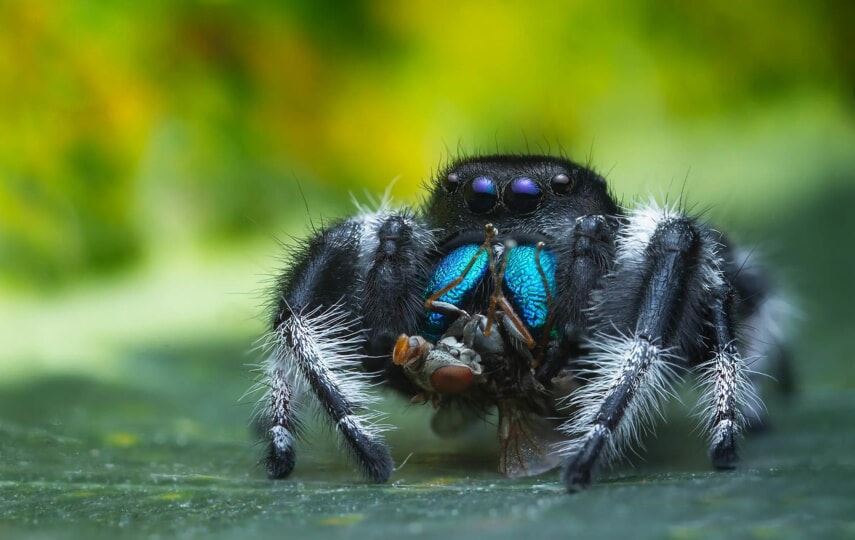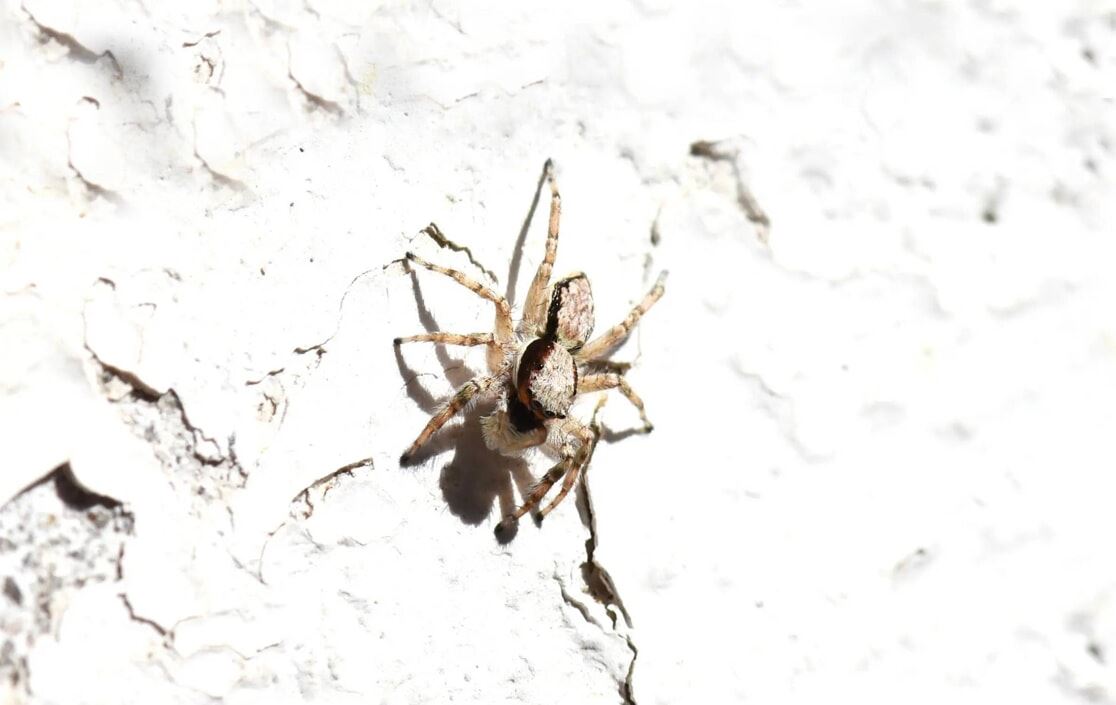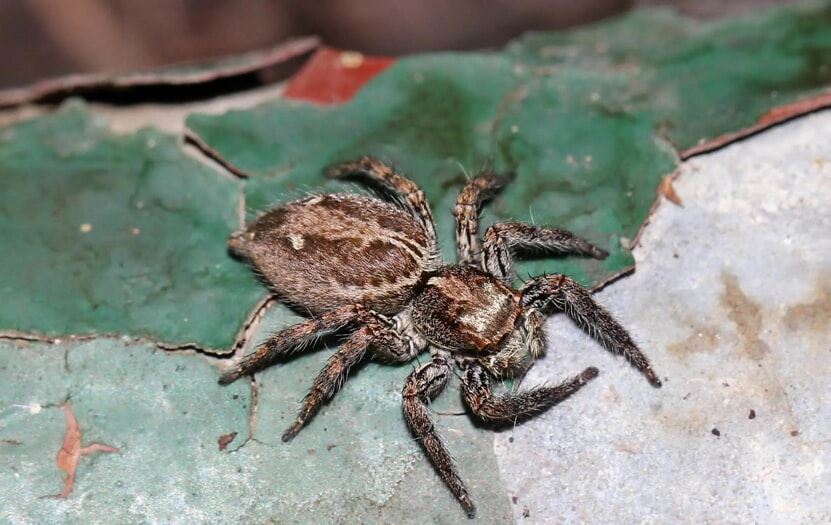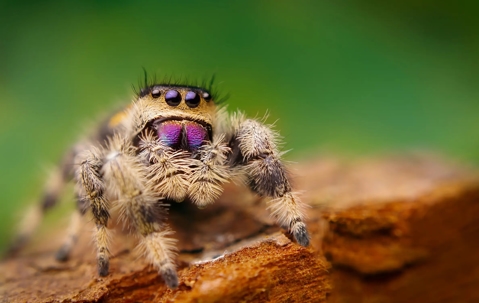Jumping Spiders in Florida: Facts, Pictures, and Pointers
Jumping spiders are the acrobats of the spider world, and Florida is their stage.
These tiny, colorful critters are everywhere, from the Panhandle to the Keys, jumping around and keeping the bug population in check.
Stick with us to dive deeper into the lives of Florida's most impressive little performers.
Key Takeaways
- Jumping spiders are known for their unique eye arrangement and impressive jumping ability, aiding their survival.
- These spiders have distinctive physical traits and vivid colors, with common species in Florida showing a range of vibrant patterns and markings.
- They adapt well to various environments, including urban areas, and their webs are used for shelter rather than hunting.
- Identifying a jumping spider infestation involves looking for visible spiders, webs, egg sacs, and spiderlings.
Identifying Jumping Spiders
To understand more about the physical traits of jumping spiders, here’s a closer look at a table that encapsulates their unique features:
Feature | Description |
Common Name | Jumping spiders |
Size | Typically small, ranging from 1 to 22 mm in length. |
Body Shape | Compact with a robust, short-legged build. |
Eye Arrangement | Four pairs of eyes with a large, forward-facing pair, giving them excellent binocular vision. |
Here are some of the common species of jumping spiders you’ll encounter in Florida:
Regal Jumping Spider

- Scientific Name: Phidippus regius C.L. Koch
- Distinctive Markings: Bold black, white, and orange hues; often marked with white spots on the abdomen; has iridescent chelicerae
Pantropical Jumper

- Scientific Name: Menemerus bivittatus
- Distinctive Markings: Duller brown or gray tones with two distinct, longitudinal white stripes on the cephalothorax and abdomen.
Wall Jumper

- Scientific Name: Plexippus paykulli
- Distinctive Markings: Typically dark with light-colored markings and bands on the legs and abdomen.
Jumping Spider Habitat
Jumping spiders thrive in various environments in Florida. They're adaptable and coexist with humans in our urban landscapes, too.
Natural Environments | Urban Environments |
|
|
Signs of Jumping Spider Infestation
Recognizing the signs of a jumping spider infestation in Florida is crucial for timely intervention.
As homeowners in Florida, you should watch for increased spider activity and the appearance of silken structures.
Visible Spiders and Webs
To help you identify a jumping spider infestation, let’s break down the key aspects to watch for and the recommended actions.
Visible Spiders and Webs
To help you identify a jumping spider infestation, let’s break down the key aspects to watch for and the recommended actions.
What to Look for | Details |
Location | Keep an eye on windows, doors, and ceilings where jumping spiders like to congregate. |
Behavior | Look for the spiders’ distinctive, jerky movements. Unlike other spiders, they’re often seen in plain sight. |
Webs | Notice the silken structures in corners and crevices. These webs are usually for nesting rather than trapping prey, differentiating them from other spider infestations. |
Common Hideouts | Check outdoor areas where jumping spiders may hide, including garden sheds and under-patio furniture. |
Egg Sacs and Spiderlings
Discovering egg sacs and spiderlings in your home can be unsettling, but it's crucial to know what to look for and how to respond.
Here's a guide to help you identify against a jumping spider infestation effectively:
Aspect | Recommended Action |
Egg Sacs Appearance | Small, papery, and typically off-white, these egg sacs are a crucial sign of infestation. |
Hiding Spots | Look for these sacs in sheltered, undisturbed places like the backs of furniture or window frame joints. |
Spiderlings | Numerous spiderlings congregating near hatched sacs indicate a growing population. |
How to Get Rid of Jumping Spiders
Jumping spiders can be expected in Florida homes, but managing them must not be challenging.
So, keeping them out effectively and moving them kindly when inside is essential.
Prevention Tips
A little prevention goes a long way to keep these agile arachnids at bay.
Consider the following checklist:
- Seal cracks and gaps in windows, doors, and foundation to block entry.
- Replace or repair damaged screens on windows and doors.
- Declutter your space to remove their potential hiding spots.
- Maintain a clean yard to reduce invertebrate populations that attract spiders.
- Use lighting that doesn't attract insects to prevent feeding opportunities.
Safe Removal and Relocation
If jumping spiders make an appearance indoors, here's how to move them out gently:
- Put on gloves to protect yourself from unintentional bites.
- Gently coax the spider into a glass or jar using paper.
- Secure the container with a breathable lid.
- Relocate the spider to an outdoor area away from the house, releasing it into the wild.
Time to Bring in the Spider Specialists?
Florida's jumping spiders are an eye-catching bunch with their intricate dance moves and bold, zebra-like patterns.
However, sometimes spider populations can leap out of control, and that's when even spider enthusiasts might need to dial professional pest control companies (like us, Native Pest Management)!
Remember, specialists are there to restore balance and peace between humans and spiders. So, if things get too 'spidery,' don’t hesitate to call in the cavalry.
